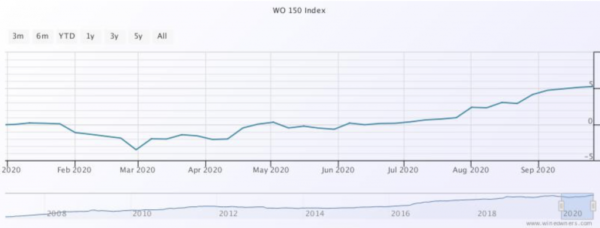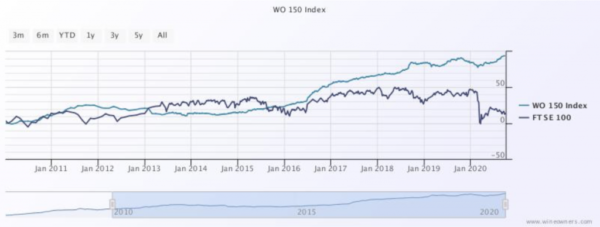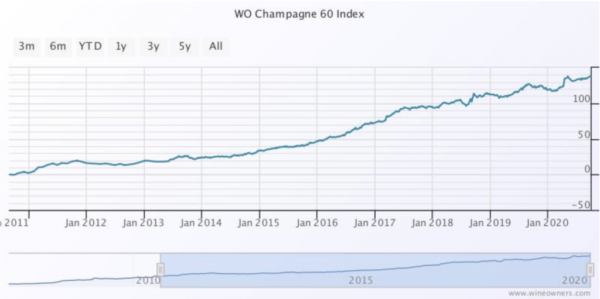Oct
2020
Alternative investments: Wine investing report
DIY Investor
26 October 2020
Given the lack of relatively significant news in the wine market, this is the first report since early in the second quarter of the year – writes Miles Davis
In fact, it is fair to say that the world of fine wine has been relatively boring, and in this world, boring is good! The lack of volatility has been impressive. The WO 150 index has (rather surprisingly) posted a gain of around 5% this year but that should come with the caveat that the constituents are older vintages and not the most liquid.

In the aftermath of the 2008 financial crisis, the major wine indices (predominantly Bordeaux led) fell sharply (by around 25%) as market players and stock holders marked down prices, desperately trying to reduce inventory.
The relative newcomer, China, was busy buying all the Bordeaux it could at the time and was presumably a little surprised by this sudden easing of prices – after all, what did wine have to do with the financial markets?
Anyway, Bordeaux prices rebounded quickly and from early 2009 to mid 2011 witnessed one of the biggest rises in prices this market has ever seen, followed by a sustained bull run for the red Burgundy recently discovered by China.
Unlike 2008, the covid-19 infested world of 2020 is yet to lead to a global banking crisis, but the economic effects will surely be felt for some time and some easing of prices would not be surprising; yet in the world of fine wine prices are not being marked down, and the indices are largely flat. There is no panic, and this is good.
As you would expect, liquidity isn’t great, spreads are wider, and there aren’t many merchants buying for stock. Overall, the volume of wine (number of bottles) traded has increased although there are widespread reports of the value being lower – hardly surprising.
Here’s the WO 150 vsersus the FTSE in the last ten years:

Other than a reasonably successful 2019 en primeur campaign, of which more later, Bordeaux has maintained its trend of recent years – its market share continues to slide.
In August it hit a new all-time low of 35%, according to our friends at Liv-ex. Ten years ago that number was 95%! It is still easily the most liquid market, however, and that should not be forgotten in times of stress.
Lafite and Mouton Rothschild still dominate Asian demand but long gone are the days when the prices just kept on rising; they are flat.
The 2019 Bordeaux en primeur campaign was highly unusual, in many respects. Not only did it happen in lockdown, it happened, apart from the locals, without any but the top wine journalists tasting any of the wines – unheard of!
We decided to listen more to Jane Anson (Decanter) and James Lawther (jancisrobinson.com), both based locally, than to other international critics after reports of samples being abandoned on melting driveways and being flown around the world in a rush; it just seemed more prudent.
The consensus, however, or whatever, was that it was another fabulous vintage and even came out with the highest average scores in fifteen years – no mean feat.
The other strange thing that happened was that some chateaux priced the wine attractively. Prices needed to be 20%-30% below 2018 prices to sell through, and some were.
The leading names for relative value and quality were the Lafite (including L’Evangile) and Mouton stables, Pontet Canet, Palmer, Canon and Rauzan Segla.
The campaign came as a much-needed boost to Bordeaux’s flailing reputation, but it took some extreme circumstances to bring it about. In terms of wine, Bordeaux is doing nothing wrong, it is the pricing that is the issue.
The super-fabulous-amazing 2016 Piedmont vintage has been dribbling into the market, some via the grey market European trade and some from agent releases.
Given the general mood, these have been easier to accumulate than in a non-virus savaged world and without an organised primeur release. Who knows how well these wines would sell if you had all the merchants shouting their virtues from the rooftops at the same time?
The super-fabulous-amazing 2016 Piedmont vintage has been dribbling into the market, some via the grey market European trade and some from agent releases
Three wines, all with 98 points from Monica Larner, that make sense and that I have bought are: Cavallotto Bricco Boschis (£260 per six), Elio Grasso Gavarini Chiniera (£375) and G.D. Vajra Bricco delle Viole (£360).
Luciano Sandrone’s Le Vigne 2016 was awarded the magical three-digit score (ML also) which sent the price from about £550 to £1,250 before settling at around £1,100 now. From the same estate, Aleste (formerly Cannubi Boschis), with a mere 98 points, makes sense at £650.
he official UK release from Roberto Conterno will be in October and although they are not yet scored, I have been accumulating in the grey market. They have decided not to make Monfortino in ’16 as it’s not the right style (!!??), which can only leave Cascina Francia as one of the buys of the decade, but what do I know?
As readers know, I am a keen fan of Italian wines for the portfolio, particularly Piedmont and Tuscany, and wines from here can easily take greater supporting roles.
The lead roles of Bordeaux and Burgundy have never felt more questioned. Super Tuscans are well developed in terms of the market and continue to do well; other Tuscan wines to a lesser degree. Both 2015 and 2016 were epic years in Tuscany, as we already know, but the ’16 releases of Brunello are still to come and there will be opportunities ahead.
This interplays with the theme of new areas becoming more accessible and more interesting. The rise of the new world continues gradually as the depth of this market grows.
Wine knowledge is on the up, price transparency and trading channels are ever more abundant, so competition from other areas is bound to increase. Quality from everywhere is on the up and the international market is flourishing.
The Champagne market deserves more on the limelight too. Here is the ten-year chart of the WO Champagne 60 index, a smooth 9% annualised, with barely a bump in the road:

Burgundy is in a funny place right now. The froth had definitely been blown off the top end of the market even before the pandemic struck, and the usual suspects do not just fly out of the door any more.
There is still demand for DRC, but it needs to be in OWC. Buying is to order, not for stock, and prices need to be sharp to attain a sale. The performance of collectable white Burgundies has been greater than their red counterparts recently, and this is a very interesting area.
Buy top quality producers at an early stage and do not hold on too long – the fear of premox has not disappeared entirely!
Keep an eye out for South African wines, mainly for the drinking cellar at the moment, but quality and media coverage are on the rise.
Good drinking!
First published by our friends at:

Leave a Reply
You must be logged in to post a comment.